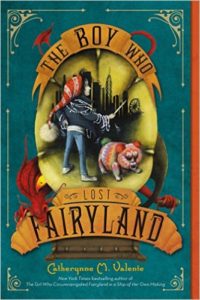By the penultimate book in the Fairyland series, my reading of them has fallen into a certain pattern: I struggle a bit in the first parts, while the author rattles off so many new characters, items and places so quickly that I get sort of a literary sensory overload. Not only that, they arrive so randomly that I begin to wonder whether the writer has missed the key trick of the fantastical and whimsical, making it seem that there is a hidden logic, a connection that the reader will see in due course. At the beginning of each book, Fairyland feels like it is going out of its way to skip that connection, to announce with its sheer randomness that things are Very Different there. That almost kept me from finishing the first, the wonderfully titled The Girl Who Circumnavigated Fairyland in a Ship of Her Own Making. Who could resist a book with “Circumnavigated” in the title? Not me.
I’m glad that I persevered. Once the world settles down a bit, there’s a wonderful story with a solid emotional core to it. I had similar experiences reading the second, The Girl Who Fell Beneath Fairyland and Led the Revels There, and the third, The Girl Who Soared Over Fairyland and Cut the Moon in Two. And so I was not surprised that the beginning of The Boy Who Lost Fairyland started out in much the same register, despite the change in protagonist and partial shortening of the title. The Red Wind arrives with the Panther of Rough Storms and carries off Hawthorn, a troll. The moment of his departure gives a sense of the furious pace of the first few chapters:
The Panther of Rough Storms picked up Hawthorn in his soft mouth just as any cat might do to a naughty kitten. The great black cat lifted the troll out of his whale-skull cradle, out of his lovely familiar nursery with its wallpaper of garnets and big, blue, long-lashed eyes, out of his underground house, leaving a parlorful of untidy green and violet queens’ crowns with enchantments still clining to their prongs by the skin of their teeth.
One enchantment had been cast by Hawthorn’s father, who, at that moment, lay sleeping in a long mulled-wine-colored magician’s cloak, snoring smoke-rings in his bed of green butterflies with a want clutched in his arms like a teddy bear and gleaming things on his sleeping cap. It was meant to keep his son from marauding pirates, of whom he had an irrational fear.
One had been cast by Hawthorn’s mother, who, at that moment, was bending over an overturned church bell full of leprechaun teeth in a distant midnight meadow, her arm muscles bulging. It was meant to keep her son safe from marauding disappointments, of which she had too much experience for any one troll.
One had been cast by a cabbage-gnome a hundred years ago. It was meant to wilt the leaves of anyone who forgot the gnome’s birthday. Of these enchantments, one missed its mark, one bided its time, and one had no effect whatsoever, as trolls have very few leaves. (p. 3)
This is Chekhov’s cabinet of curiosities.
Eventually — quickly, in fact, the book is less than 250 generously spaced pages — the tale settles down enough to focus on what happens to Hawthorn after the Red Wind whisks him out of Fairyland and delivers him, a Changeling, into our world. It’s a tale of someone trying to fit in, and then discovering that he can do much better than merely fit in once he decides to be himself. “Much better” in this case meaning to the dismay of his teachers and the delight of his fellow schoolchildren, whom he convinces of many improbable things.
But Hawthorn doesn’t just feel out of place, he really is out of place and so, as he eventually discovers during a memorable baseball game, is his friend, a girl named Tamburlaine. The Fairyland books are growing up, and boys and girls discovering each other, sharing secrets, making magic together and exploring new worlds is part of that. Except of course it’s also very literally the stuff of the story. Tamburlaine helps Hawthorn remember he’s a changeling, at the same time as she shows him her true nature. The magic they make together includes animating many of the objects in Tamburlaine’s house. And the world they explore is of course Fairyland. Crossing that border is the high point of the book, although it occurs about two-thirds of the way through, as it resolves the main conflict of the story. The rest of the book is just as delightful, but it also sets up the final volume in the series, The Girl Who Raced Fairyland All the Way Home. Hawthorn and Tamburlaine find that they are not the only Changelings, not the only people to have crossed into Fairyland. They meet September, protagonist of the first three books; there are intimations that all is not well in the balance between our world and Fairyland; and Something Must Be Done.
The Boy Who Lost Fairyland is splendid fun with a big heart, but as the fourth in the series and clear lead-in to the fifth and final book, it’s definitely not the place to start. The old advice of the King of Wonderland applies to Valente’s set.


1 pings
[…] setup at the end of The Boy Who Lost Fairyland — intimations that all is not well in the balance between our world and Fairyland; and Something […]